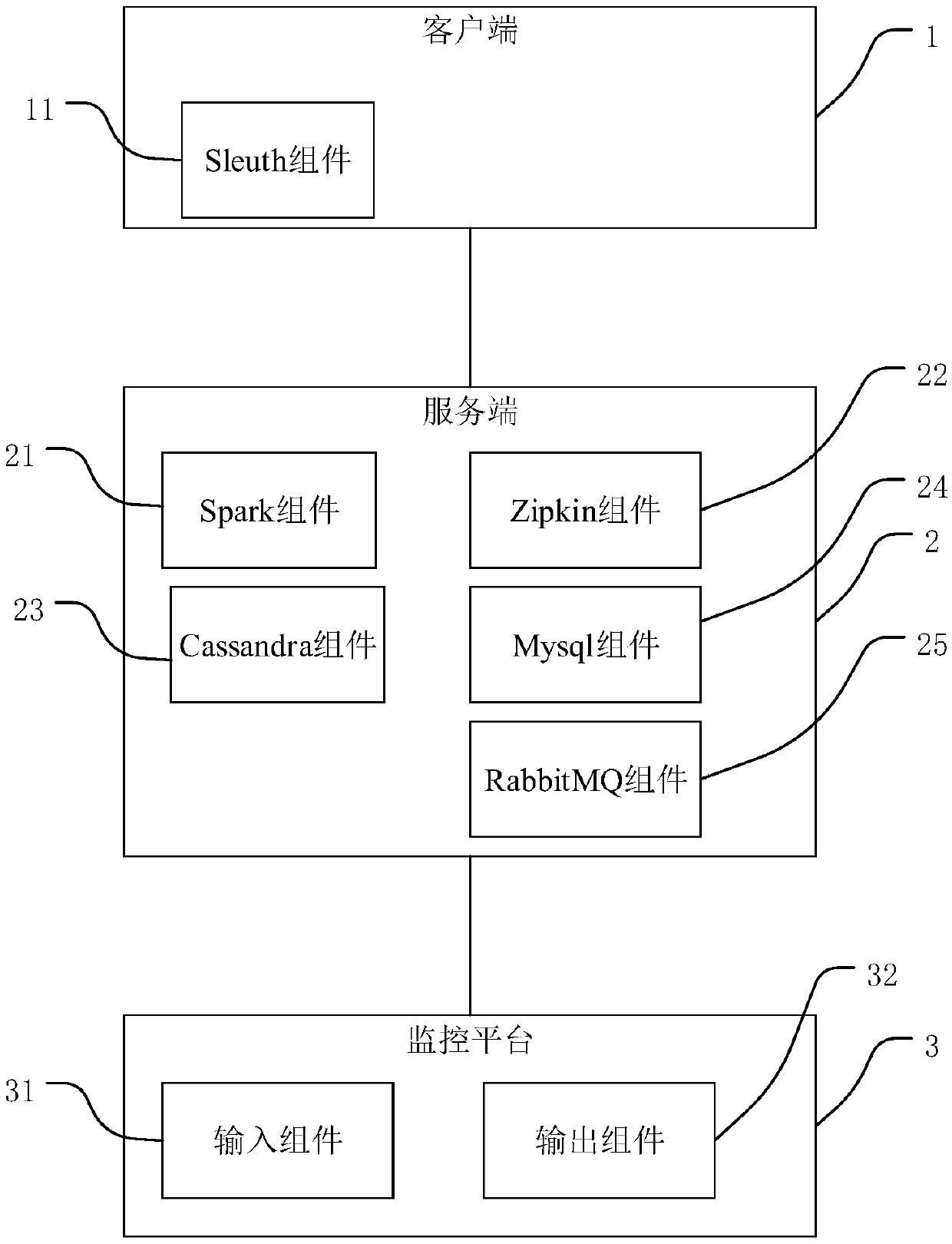Link monitoring system
A monitoring system and link technology, applied in transmission systems, digital transmission systems, electrical components, etc., can solve problems such as resource consumption, high deployment complexity, and increased difficulty in node positioning, and achieve the effect of realizing control and quickly processing data
- Summary
- Abstract
- Description
- Claims
- Application Information
AI Technical Summary
Problems solved by technology
Method used
Image
Examples
Embodiment 1
[0018] This example provides figure 1 The shown link monitoring system includes: a client 1, a server 2 and a monitoring platform 3, wherein the client 1 includes a Sleuth component 11 for obtaining link data from an application request; the server 2 includes The Spark component 21 for parsing link data to obtain metric data, the Zipkin component 22 for integrating the link data into a complete link and storing the analyzed data in the database, for storing the parsed data The Cassandra component 23 and the Mysql component 24 for storing link data, and the RabbitMQ component 25 for managing push information; the monitoring platform includes an input component 31 for setting processing rules, and an output component 32 for outputting data processing results.
[0019] Components in the system:
[0020] Sleuth (ie Spring Cloud Sleuth): As the core of the client, it is used to collect link information of various requests, and can collect link data of Http requests, Dubbo requests...
Embodiment 2
[0042] In this embodiment, the link becomes longer and more complex, which makes it difficult to troubleshoot and analyze the problem. The reason is that the link becomes longer and more complex, and the data is requested across systems. , show, propose and illustrate preferred options, such as figure 2 The shown link data acquisition process:
[0043] S1. The user sends a request to access the A application (that is, the target application) through the browser, and the A application records (recording point) the receiving time of the server side of SpanA.
[0044] S2. After application A receives the request, it calls the interface of application B (ie, a third-party application) to create SpanB and record the time when the Client (client) request is initiated.
[0045] After the S3.B application receives the call request from the A application, it records the reception time of the server side of SpanB, and executes the business code (that is, executes the request called by...
Embodiment 3
[0052] This example is used to explain the preferred solution.
[0053] The server parses and processes the data correspondingly, and the specific steps include:
[0054] Analyze link data: The analysis time interval can be dynamically adjusted. The purpose is to analyze the data of the longest link in the link from the link data within a certain time range, and analyze the most time-consuming node in the link. , and determine whether an alert needs to be triggered. Its main processing process is to obtain all link data into memory, analyze the data set of all root nodes under the condition that the parent node is empty, and then use the root node name as a group to obtain the longest node in a link. Name, id, time-consuming result set; analyze the data of each number of links in the result set separately, remove the processing time of the child nodes from the time of each node in the link, and obtain the running time of each node's own code. The link data and the running ti...
PUM
 Login to View More
Login to View More Abstract
Description
Claims
Application Information
 Login to View More
Login to View More - R&D Engineer
- R&D Manager
- IP Professional
- Industry Leading Data Capabilities
- Powerful AI technology
- Patent DNA Extraction
Browse by: Latest US Patents, China's latest patents, Technical Efficacy Thesaurus, Application Domain, Technology Topic, Popular Technical Reports.
© 2024 PatSnap. All rights reserved.Legal|Privacy policy|Modern Slavery Act Transparency Statement|Sitemap|About US| Contact US: help@patsnap.com









